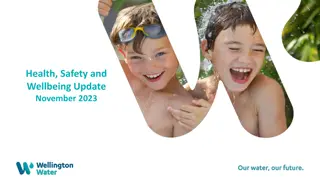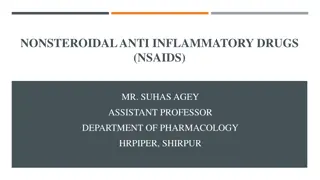Anticonvulsants drugs
Phenytoin is an anticonvulsant drug used for various seizure disorders. It acts by inactivating sodium ion channels to reduce neuronal firing. The medication's kinetics, serum concentration-related side effects, and monitoring issues are essential aspects to consider when administering Phenytoin.
Download Presentation
Please find below an Image/Link to download the presentation.
The content on the website is provided AS IS for your information and personal use only. It may not be sold, licensed, or shared on other websites without obtaining consent from the author. Download presentation by click this link. If you encounter any issues during the download, it is possible that the publisher has removed the file from their server.
Presentation Transcript
Anticonvulsants drugs Asist. Prof. Dr. Jubran K. Hassan Department of Clinical Pharmacy
Phenytoin 2 Clinical uses is an anticonvulsant medication used for many types of seizure disorders. like tonic-clonic (grand mal) or partial seizures and for the acute treatment of generalized status epilepticus. As second line agent Phenytoin is a type 1B antiarrhythmic and is also used in the treatment of trigeminal neuralgia Mechanism of action By inactivation of voltage-activated sodium ion channels and reduction the ability of neurons to fire at high frequencies.
Phenytoin : Kinetics parameters 3 Bioavailability (F) 0.9 - 1 considered 100% 0.92 - Phenytoin Na+(caps, IV) 1.0 - Phenytoin Acid (tabs, susp) Salt Factor (S) Protein Binding 90% , Fu=0.1 0.7L/Kg Adults 1.0L/Kg - Children Volume of Distribution (Vd) Vm= 7mg/kg/day ; Km =4mg/L (capacity limited) Clearance (CL) 8- 60 hrs ; aver. 22 hrs (conc. dependent) Half life (t0.5) 1-5% unchanged in urine Hepatic capacity limited metabolism (Zero order) Elimination 10 -20 mg/L or 40-80 umol/L Cpss 1 4 weeks (longer with higher doses ) Time to steady state L.D = 15-18 mg/kg at max rate 50mg/min M.D = 5 7 mg/kg /day in divided 2-3 doses Dosing (PO or IV only)
Phenytoin : Serum Conc. Related Side effects 4 10 mg/L Usually no side effects Drawsiness , Fatigue >15 mg/ L 20 mg/L Nystagmus esp. at lateral gaze ataxia, slurred speech, and/or incoordination similar to ethanol intoxication can be observed 30mg /L 40 mg/L severe confusion or lethargy, and coma are possible Drug-induced seizure 50 -60 mg/L
Phenytoin : Monitoring problems 5 Alteration of protein binding INSUFFICIENT ALBUMIN CONCENTRATION (HYPOALBUMINEMIA) like nephrotic syndrome; is ever liver disease; pregnancy ..etc DISPLACEMENT BY ENDOGENOUS COMPOUNDS Like in hyperbilirubinemia & uremia DISPLACEMENT BY EXOGENOUS COMPOUNDS Like Drugs such as Warfarin , valproic acid , asprin >2g , NSAID with highly protein binding When multiple factors that decrease phenytoin plasma protein binding are present in a patient, the free fraction can be as high as 30 40% and free concentration will be much elevated; and alter expected response from a given dose.
Phenytoin : Altered plasma protein binding 6 Unbound phenytoin serum concentrations should be measured in patients with factors known to alter phenytoin plasma protein binding. For interpretation of plasma concentration of phenytoin is better to correct the observed plasma concentration with low binding to plasma concentration at normal conditions, this will make less calculation errors equation for correction is: ? ??????? ???????= ? ??? + ?? ? ?? Or ???????? ????????? ????. ??????? ????? ??????? ?.??/?? ??????? ???????= ? ?.? + ?.?
Phenytoin : Altered plasma protein binding 7 ???????? ????????? ????. ?? ?/?? ??????? ????? ??????? ?.??/?? ??????? ???????= ?.? + ?.? ? The value of 0.9 = ?.? at 37 C0 or 25 at 25 C0 or 0 0. .25 ?.?? ??? ?? The value could represented as X Then the equation will be ??????? ???????=???????? ????????? ????. ?? ?/?? ? (??????? ????? ???????) + ?.? in most clinical laboratories protein binding is determined at room temperature (25 C) so X will be 0.25 X will be multiply by 0.48 if there is ureamia or end stage renal failure (creatinine clearance <10 15 mL/min ) and could be = 0.1
Phenytoin : Altered plasma protein binding 8 Then the final equation will be ??????? ???????=???????? ????????? ????. ?? ?/?? ? (??????? ????? ???????) + ?.? X= 0.25 at 25C0 in case of hypoalbuminemia X= 0.1 at 25C0 in case of hypoalbuminemia & renal impairement In case of drug displace phenytoin from protein binding site is difficult to estimate extent of drug displacement since conc. Of displacing agent is unknown except if phenytoin and valproic acid are monitored together. Especially if valproic acid serum conc.>20mg/L Then the final equation will be ??????? ??????? =[(?.??? + ?.??? ???)][???????? ????????? ????. ?? ? ??? ??] ?.? VPA conc. in ? ??? ??
Phenytoin : Altered plasma protein binding 9 Example 1 JM is an epileptic patient on phenytoin. He has serum (albumin = 2.2 g/dL) and creatinine clearance 90 mL/min). His total phenytoin concentration is 7.5 g/mL. Assuming that any unbound concentrations performed by the clinical laboratory will be conducted at 25 C, A- Compute an estimated normalized phenytoin concentration for this patient. Answer : use equation to correct plasma conc. of phenytoin to normal binding. X =0.25 at 25C0 . The patient creatinine clearance arround normal >15 ml/min . And valproic acid was not concomitantly used ; so the equation selected is ??????????????=???????? ????????? ????. ?? ?/?? ? (??????? ????? ???????) + ?.? = 7.5 g/mL /[ (0.25* 2.2g/dl)+0.1] = 11.5 g/mL and Cfree = Ctotal .Fu then 11.5* 0.1= 1.15 g/mL
Phenytoin : Altered plasma protein binding 10 Example 1 B- Compute an estimated normalized phenytoin concentration for this patient. If creatinine clearance was 10ml/min Answer : use equation to correct plasma conc. of phenytoin to normal binding. X =0.1 at 25C0 . The patient creatinine clearance <15 ml/min. And valproic acid was not concomitantly used ; so the equation selected is ??????? ???????=???????? ????????? ????. ?? ?/?? ? (??????? ????? ???????) + ?.? = 7.5 g/mL /[ (0.1* 2.2g/dl)+0.1] = 23.4 g/mL and Cfree = Ctotal .Fu then 23.4* 0.1= 2.34 g/mL
Phenytoin : Altered plasma protein binding 11 Example 2 PM is an epileptic patient being treated with phenytoin and valproic acid. He has a normal albumin concentration (albumin = 4.2 g/dL) and normal renal function (creatinine clearance = 90 mL/min). His steady-state total phenytoin and valproic acid concentrations are 7.5 g/mL and 100 g/mL, respectively.. A- Compute an estimated normalized phenytoin concentration for this patient. Answer : use equation to correct plasma conc. of phenytoin to normal binding. The patient creatinine clearance arround normal >15 ml/min . And valproic acid was concomitantly used ; so the equation selected is ??????? ??????? =[(?.??? + ?.??? ???)][???????? ????????? ????. ?? ? ??? ??] ?.? = [(0.095+0.001* 100)][7.5]/0.1 = 15 g/mL and Cfree = Ctotal .Fu then 15* 0.1 = 1.5 g/mL
Phenytoin : Volume of distribution 12 Volume of distribution : if plasma protein & renal function are normal ; is estimated as 0.65L/kg for non obese patient. While for obese patient the Vd is corrected as follow equation: Vd=0.7L/kg * [IBW+1.3(TBW-IBW)] IBW is ideal body weight in kilograms IBW(in kg) = Gf *(50) + 2.3(Ht(inches) 60) Gf =gender factor =1 for male and 0.9 for female Again any plasma concentration observed under altered plasma protein binding should be corrected to concentration under normal protein binding Phenytoin Vd is unaffected by saturable metabolism and is still determined by the physiological volume of blood (VB) and tissues (VT) as well as the unbound concentration of drug in the blood (fB) and tissues (fT): Vd = VB+ (fB/fT)VT.
Phenytoin : Clearance 13 by hepatic metabolism (>95%). mainly via the CYP2C9 enzyme system with a smaller amount metabolized by CYP2C19. About 5% of a phenytoin dose is excreted in urine as unchanged drug. Phenytoin follows Michaelis-Menten or saturable pharmacokinetics. This is the type of nonlinear pharmacokinetics that occurs when the number of drug molecules >> enzyme s ability to metabolize the drug. Here, CSS increase in a disproportionate manner after a dosage increase To find out Clearance of phenytoin re- arrangement of Michaelis- Menten equation is required
Phenytoin : Clearance 14 ???? ??+??? ??? ??? ??? dX/dt = Where dX/dt Vmax = is the maximum rate of metabolism in mg/d Km = Km is the substrate concentration in mg/L, and where the rate of metabolism = 0.5 *Vmax Css = average steady-state phenytoin concentration. dX/dt = the change in the amount of drug (X) over time (t), can be expressed as X0/dt (dose over dosing interval) or can be expressed as (S)(F)(Dose)/T So (?)(?)(????)/? = ??+??? ??? ? ? ???? ? ???? ??? ??? Since Since ???? = (??)(??? ???) so ??? ???????= ??+??? ???
Phenytoin : Clearance 15 ??????? ??? ??+??? ???Represents maintenance dose of So (?)(?)(????)/? = phenytoin at steady state (M.D) Phenytoin could follow first order kinetic if the Css << Km so that it could be ? ? ???? ? = ???? ??css avehere Vmax/Km =CL negligible
Phenytoin : Dosage form, S & F factors effects 16 Phenytoin Parenterally Orally BY N.G tube - absorbition of oral dosage forms Phenytoin Na+ Phenytoin Na+ FosPhenytoin Phenytoin S=0.92 P.E=0.92* S=0.92 S=1 relatively insoluble in water Phosphate Ester salt soluble in water -Extended release cap F=100% -Tablets Suspension F=100% -Possibly due to: - Gastrointestin al transit time - - Solvent is propylen glycol or ethanol Solvent is Water 1-2 dose/day 2 dose/day -binding to proteins In Enteral feeding Cause IV =NO Hypotension IM= Rapid absorption No pain PH 10 - 12 Changes in dosage form will provide different plasma concentration; so they need dose calculation or they are non interchangible Cause -Solution: -Stop feeding 1-2 hr before & after Phenytoin administration IV = Hypotension IM= Preceptation & pain F IV=100% F IM= variable F IV=IM=100%
Phenytoin : Impact of altered plasma protein binding on phenytoin pharmacokinetics 17 ?? ????? ?? ????? ?? ??????? = ??. ?? + Phenytoin is low extracted ER<30% so ??>> ?? ????? ?? ????? ?? So ?? ??????? = ??. = ?? ????? So if ?? of phenytoin is elevated this will result in ?? ????? ?? ?? ?? = ?? ????? ?? = ?????? + ( ???????/????????).??????? ?? ?0.5 ??? ?0.5= 0.693 ?? /?? ?.? = ??????. ?? ??? Unb ??????= ??? .?? ??????
Phenytoin : Impact of Valproic acid on phenytoin pharmacokinetics 18
Phenytoin : Dosage determination methods 19 Pharmacokinetic method by Mechaelis -Menten equation If the patient has normal liver & renal function , & with normal plasma protein binding . Using already estimated Vmax and Km values Age group Km Vmax Adult 7mg/kg/day 4 mg/L 6 months 6 years 12mg/kg/day 6 mg/L 9mg/kg/day 7 16 years 6 mg/L Example 1TD is a 50-year-old, 75-kg (5 ft 10 in) male with simple partial seizures who requires therapy with oral phenytoin. He has normal liver and renal function. Suggest an initial phenytoin dosage regimen designed to achieve a steady-state phenytoin concentration equal to 12 g/mL. Answer Patient was non obese, using adult values of Vmax and Km Vmax=7mg/kg/day *75 kg=525 mg/day Km=4mg/L Convert 12 g/mL to mg/L =12mg/Liter M.D=Vmax.css/Km+css= (525)(12)/(4+12)=6300/16=393.75 mg/day of phenytoin Select dosage form & salt = Use phenytoin cap contains Na salt S=0.92,F=1 So dose of capsule /day == 393.75/(1)(0.92) = 428mg/day 400mg/day
Phenytoin : Dosage determination methods 20 Pharmacokinetic method by Mechaelis -Menten equation Example 2UO is a 10-year-old, 40-kg male with simple partial seizures who requires therapy with intravenous fosphenytoin. He has normal liver and renal function. Suggest an initial phenytoin dosage regimen designed to achieve a steady-state phenytoin concentration equal to 12 g/mL. Answer Patient was non obese, using adult values of Vmax and Km Vmax=9mg/kg/day *40 kg= 360 mg/day Km=6mg/L Convert 12 g/mL to mg/L =12mg/Liter Vd=0.65 0.7L/kg =0.7*40 = 28 Liters LD= Vd* Css desired == 28*12=336mg of phenytoin =336/(0.92)(1)=365mg 350mg/day of fosphenytoin could be given in rate 150 mg/min M.D=Vmax.css/Km+css= (360)(12)/6+12=4320/18=240 mg/day of phenytoin Select dosage form & salt = Use fosphenytoin inj. S=0.92,F=1 So dose /day == 240/(1)(0.92) = 261mg/day 250mg/day Fospheytoin could be given as 125 mg bid to the patient Re check required after 7 -14 day after achieve css
Phenytoin : Dosage determination methods 21 Literature-Based Recommended Dosing many clinicians believe that the use of standard phenytoin doses for various situations are warranted. That due to great variability in phenytoin pharmacokinetics. Target plasma conc. 10 15 g/mL. Suggested phenytoin maintenance doses are 4 6 mg/kg/d for adults for children (6 months 16 years old) dose is 5 10 mg/kg/d . Phenytoin loading doses are 15 20 mg/kg. For obese individuals (>30% over ideal body weight), adjusted body weight (ABW) should be used to compute loading doses Example 1TD is a 50-year-old, 75-kg (5 ft 10 in) male with simple partial seizures who requires therapy with oral phenytoin. He has normal liver and renal function. Suggest an initial phenytoin dosage regimen designed to achieve a steady-state phenytoin concentration equal to 12 g/mL. Answer Patient was non obese, initial dosage rate 4 6 mg/kg/d. Using a rate of 5 mg/kg/d, 5 * 75 kg=375 mg/day of phenytoin Select dosage form & salt = Use phenytoin cap contains Na salt S=0.92,F=1 So dose of capsule /day == 375/(1)(0.92) = 408mg/day 400mg/day
Phenytoin : Dosage determination methods 22 Literature-Based Recommended Dosing Example 2UO is a 10-year-old, 40-kg male with simple partial seizures who requires therapy with intravenous fosphenytoin. He has normal liver and renal function. Suggest an initial phenytoin dosage regimen designed to achieve a steady-state phenytoin concentration equal to 12 g/mL. Answer Patient was non obese, The suggested initial dosage rate for fosphenytoin injection in an adolescent patient is 5 10 mg/kg/d PE. Using a rate of 6 mg/kg/d, 6*40= 240 mg/day Convert 12 g/mL to mg/L =12mg/Liter Vd=0.65 0.7L/kg =0.7*40 = 28 Liters So dose /day == 240/(1)(0.92) = 261mg/day 250mg/day Fospheytoin could be given as 125 mg bid to the patient Re check required after 7 -14 day after achieve css
Phenytoin : Dosage Alteration methods 23 Single Total Phenytoin Steady-State Serum Concentration Methods Empiric dosing method Based on the knowledge of population Michaelis-Menten pharmacokinetic parameters, itis possible to suggest empiric dosage increases for phenytoin when one steady-state serum concentration is available using following table Suggested Dosage increase Phenytoin conc. mg/L <7 100 mg/day or more 7 -12 50 -100 mg/day 30 -50 mg/day >12 Example 1TD is a 50-year-old, 75-kg (5 ft 10 in) male with simple partial seizures who requires therapy with oral phenytoin. He has normal liver and renal function. he used 400mg/day capsule for 1 month and on visit measured steady-state phenytoin total concentration equals 6.2 g/mL . Suggest an initial phenytoin dosage regimen designed to achieve a steady-state phenytoin concentration within the therapeutic range. Answer plasma equals to 6.2 g/mL ;according to the table the dose should be increase by at least 100mg/day to be 500 mg /day Patient should be reassessed after 7-14 days
Phenytoin : Dosage Alteration methods 24 Single Total Phenytoin Steady-State Serum Concentration Methods Pseudo linear pharmacokinetic method simple, easy way to approximate new total serum concentrations of phenytoin temporarily assume linear pharmacokinetics then add 15 33% for a dosage increase or subtract 15 33% for a dosage decrease to account for Michaelis-Menten pharmacokinetics: Cssnew = (Dnew / Dold).Css old The pseudolinear pharmacokinetics method should never be used to compute a new dose based on measured and desired phenytoin concentrations. Answer example 1 sinceplasma equals to 6.2 g/mL<10 g/mL ; add 15 33% for a dosage (use 25% of old dose) the new dose will be 100+400 =500mg/day the resulting total steady-state phenytoin serum concentration would equal: Cssnew = (Dnew / Dold)Cssold = (500 mg/d / 400 mg/d)6.2 g/mL =7.8 g/mL. if it is linear. Because of Michaelis-Menten pharmacokinetics, the serum concentration would be expected to increase 15%, or 1.15 times, to 33%, or 1.33 times 1.15*7.8=9 g/mL 1.33*7.8= 10.4 g/mL So increment of dose by 100mg/day will expected to produce conc range 9-10.4 g/mL Patient should be reassessed after 7-14 days
Phenytoin : Dosage Alteration methods 25 Single Total Phenytoin Steady-State Serum Concentration Methods GRAVES-CLOYD METHOD Is to compute the patient s own phenytoin clearance rate Dnew = (Dold / Cssold) Cssnew0.199 Cssold0.804 Answer example 1 sinceplasma equals to 6.2 g/mL ; desired conc is10 g/mL Phenytoin sodium 400 mg equals 368 mg of phenytoin (400 mg 0.92 = 368 mg) = (368 mg/d / 6.2 mg/L) (10 mg/L)0.199 (6.2 mg/L)0.804 = 407 mg/d of phenytoin = 407 mg/d /0.92=442mg/day phenytoin sodium rounded to 450 mg/d, or 400 mg/d on even days alternating with 500 mg/d on odd days.
Phenytoin : Dosage Alteration methods 26 Single Total Phenytoin Steady-State Serum Concentration Methods VOZEH-SHEINER OR ORBIT GRAPH METHOD A graphical method that employs population Michaelis-Menten information using Bayes theorem can also be used to adjust phenytoin doses using a single steady-state total concentration. Example S.B is 37 years old ,70 kg man with seizure that only partially controlled by using 300mg /day of phenytoin capsules. His plasma concentration found 8 mg/Liter . Calculate maintenance dose to achieve css of 15 mg/liter. using orbit graph method Answer conc. (X= 8mg/liter) (s)(F)(dose)/T )(0.92)(1) (300mg/day)=276m g/day ==276 mg/ day of phenytoin =276/70kg= 3.94mg/kg/ day Rate of administration (Y= 3.94mg/kg/ day) Determine these data on x, y axis Then plot a line (A) pass through these data to inter most of orbit (closer to the center as possible Specify B point by making B= 15 mg/ liter on X axis application Draw line B that intercept with y axis and Line A at the inter most of orbit Point of intersection of line A&B will be the point from drop aline on X-axis to find out Km value , & on Y axis to find vmax value
Phenytoin : Dosage Alteration methods 27 Vmax Rate of administration (mg/kg/day) (mg/kg/day) 12 10 8 . .5.75.9 .95 .975 Vm =6.4mg/kg/day 6 New Dose rate =4.85 mg/kg/day 4 X Km =5mg/Liter B 2 A X X 24 20 16 12 8 4 0 4 8 12 16 Css (ug/ml) Km (ug/ml)
Phenytoin : Dosage Alteration methods 28 Single Total Phenytoin Steady-State Serum Concentration Methods VOZEH-SHEINER OR ORBIT GRAPH METHOD Answer By application in Michaelis Menten Equation we found (0.92)(1)(dose/T) =6.4*70kg*15mg/(5 +15) =365mg/day of phenytoin Na Another method Also from interception of line B with y axis; the value of interception point represents Dosing rate =4.8mg/kg/day of phenytoin = (0.92)(1)(dose/T) = 4.8*70=365 mg/day phenytoin sodium
Phenytoin : Dosage Alteration methods 29 Two or More Phenytoin Steady-State Serum Concentrations at Two or More Dosage Levels Methods EMPIRIC DOSING METHOD Using (Table 10-4).or table in slide 23 to estimate new dosage regimen after estimation of plasma conc. attained from 2 dosage Example 1 GF is a 35-year-old, 55-kg female with tonic-clonic seizures who requires therapy with oral phenytoin. She has normal liver and renal function. The patient was prescribed 300 mg/d of extended phenytoin sodium capsules for 1 month, and the steady-state phenytoin total concentration equals 10.7 g/mL. At that time, the dose was increased to 350 mg/d of extended phenytoin sodium capsules for an additional month, and the resulting steady state concentration was 15.8 mg/mL. The patient is assessed to be compliant with her dosage regimen. Suggest a new phenytoin dosage regimen increase designed to achieve a steady-state phenytoin concentration within the upper end of the therapeutic range. Answer The next logical dose to prescribe is phenytoin sodium 400 mg/d (Table 10-4). A steady-state trough total phenytoin serum concentration should be measured after steady state is attained in 7 14 days. Phenytoin serum concentrations should also be measured if the patient experiences an exacerbation of their epilepsy, or if the patient develops potential signs or symptoms of phenytoin toxicity.
Phenytoin : Dosage Alteration methods 30 Two or More Phenytoin Steady-State Serum Concentrations at Two or More Dosage Levels Methods MULLEN METHOD This dosage approach uses the same dose/concentration plot as that described for the Vozeh-Sheiner or orbit graph method, but the population orbs denoting the Bayesian distribution of Vmax and Km parameters are omitted. Example 3 TD is a 50-year-old, 75-kg (5 ft 10 in) male with simple partial seizures who requires therapy with oral phenytoin. He has normal liver and renal function. The patient was prescribed 400 mg/d of extended phenytoin sodium capsules for 1 month, and the steady-state phenytoin total concentration equals 6.2 g/mL. The dosage was increased to 500 mg/d of extended phenytoin sodium capsules for another month, the steady state phenytoin total concentration equals 22.0 g/mL, and the patient has some lateral-gaze nystagmus. The patient is assessed to be compliant with his dosage regimen. Suggest a new phenytoin dosage regimen designed to achieve a steady-state phenytoin concentration within the therapeutic range. Using the graph, the serum concentration/dose information is plotted. Convert all dosing rate to dose rate per kg and assign the point of conc. on X axis And Dosing rate on Y axis Draw line between each dose rate and it related
Phenytoin : Dosage Alteration methods 31 MULLEN METHOD Each line drawn should pass to the sector of Km value Point of intersection of these line represents the point of determination of Km (by drop line on X-axis and used to determine Vmax by plot line to y axis Then data of Km & vmax could be used to calculate the dosage of new desired conc. Or plotting a line(line C ) from point of desired plasma conc. On x-axis to the point of determination , the point of intercept will represent new dosage rate Answer Convert dosing rate to dose per kg (s)(F)(dose/T) /weight (0.92)(1)(400mg/day)/75= 4.9mg/kg/day produce conc. 6.2 mg/L (0.92)(1)(500mg/day)/75= 6.1mg/kg/day produce conc. 22 mg/L According to the graph, a dose of 5.5 mg/kg/d of phenytoin is required to achieve a steady-state concentration equal to 11.5 g/mL. This equals an extended phenytoin sodium capsule dose of 450 mg/d, administered by alternating 400 mg/d on even days and 500 mg/d on odd days: (5.5 mg/kg/d 75 kg) / 0.92 = 448 mg/d, rounded to 450 mg/d. Vmax = 6.8 mg/kg/d and Km = 2.2 g/mL for this patient.
Phenytoin : Dosage Alteration methods 32 Vmax Rate of administration (mg/kg/day) (mg/kg/day) 12 10 8 Vm =6.8mg/kg/day X New Dose rate =5.5 mg/kg/day 6 X 4 Km =2.2mg/Liter B 2 C A X X X 24 20 16 12 8 4 0 4 8 12 16 Css (ug/ml) Km (ug/ml)
Phenytoin : Dosage Alteration methods 33 Two or More Phenytoin Steady-State Serum Concentrations at Two or More Dosage Levels Methods LUDDEN METHOD This method involves the arrangement of the Michaelis-Menten equation so that two or more maintenance doses (MD, in mg/d of phenytoin) and steady-state concentrations (Css in mg/L = g/mL) can be used to obtain graphical solutions for Vmax and Km ??????? ??? ??+??? ??? ???? ?.? = ?.?/ ??????= ??+??? ??? ???? ??.?? + ??.??? ???= ???? ?? = ??+??? ??? ??.?? + ?.? = ???? ?.? = ??.?? + ???? ?.? = ??.[?.?/ ??? ???] + ???? ? = ?. ? + ?
Phenytoin : Dosage Alteration methods 34 Two or More Phenytoin Steady-State Serum Concentrations at Two or More Dosage Levels Methods LUDDEN METHOD Example 3 TD is a 50-year-old, 75-kg (5 ft 10 in) male with simple partial seizures who requires therapy with oral phenytoin. He has normal liver and renal function. The patient was prescribed 400 mg/d of extended phenytoin sodium capsules for 1 month, and the steady-state phenytoin total concentration equals 6.2 g/mL. The dosage was increased to 500 mg/d of extended phenytoin sodium capsules for another month, the steady state phenytoin total concentration equals 22.0 g/mL, and the patient has some lateral-gaze nystagmus. The patient is assessed to be compliant with his dosage regimen. Suggest a new phenytoin dosage regimen designed to achieve a steady-state phenytoin concentration within the therapeutic range. Answer Because only two dose/steady-state concentrations pairs are available, a direct mathematical solution can also be conducted: Km(slope) = (MD1 MD2) / [(MD1/Css1) (MD2/Css2)] =(460 mg/d 368 mg/d) / [(460 mg/d / 22 mg/L) (368 mg/d / 6.2 mg/L)] = 2.4 mg/L, Km =2.4 mg/L; Vmax = MD + Km(MD/Css) = 368 mg/d + 2.4(368 mg/d / 6.2 mg/L) = 510 mg/d. Lets consider the desired plasma conc. Is 10.4 mg/L; then by application of data of Css, New Vmax, Km In mechaelis menten equation the dose will be 450 mg/day
Phenytoin : Dosage Alteration methods 35 Two or More Phenytoin Steady-State Serum Concentrations at Two or More Dosage Levels Methods LUDDEN METHOD Answer Also BY plotting data Dose in mg/day of phenytoin on Y axis and dose/css on x axis then graphically determine Vmax & Km Using the graph, the serum concentration/dose information is plotted. (Note: Phenytoin dose = 0.92 phenytoin sodium dose = 0.92 400 mg/d = 368 mg/d; produce conc. of 6.2 mg/L Cl=MD/Cssave =368/6.2=59.4L/d 0.92 500 mg/d = 460 mg/d, produce conc. Of 22mg/L Cl=MD/Cssave = 460/22= 20.9L/d According to the graph, Vmax =510 mg/d and Km = 2.4 mg/L. Lets consider the desired plasma conc. Is 10.4 mg/L; then by application of data of Css, New Vmax, Km In mechaelis menten equation the dose will be 450 mg/day BAYESIAN PHARMACOKINETIC COMPUTER PROGRAMS
Phenytoin : Dosage Alteration methods 36 Y Intercept = Vmax = 510mg/day 600 (460 ;20.9) 500 X Dose in (mg/day) (368 ;59.4) 400 X -Slope= Km =2.4mg/Liter 300 200 100 10 20 30 40 50 60 Clearance (dose/Css)
Phenytoin : Dosage Alteration methods 37 BAYESIAN PHARMACOKINETIC COMPUTER PROGRAMS Summary of dosing strategies
Phenytoin : Booster doses to immediately increase serum conc. 38 If a patient has a sub-therapeutic phenytoin serum concentration in an acute situation, it may be desirable to increase the phenytoin concentration as quickly as possible. In this setting, it would not be acceptable to simply increase the maintenance dose and wait for therapeutic steady-state serum concentrations to be established in the patient. A rational way to increase BD = [(Cdesired Cactual)V] / S Volume of distribution should be corrected for For obese individuals 30% or more above their ideal body weight using following equation Vd=0.7L/kg * [IBW+1.3(TBW-IBW)] IBW is ideal body weight in kilograms IBW(in kg) = Gf *(50) + 2.3(Ht(inches) 60) Gf =gender factor =1 for male and 0.9 for female
39 Thank you









































